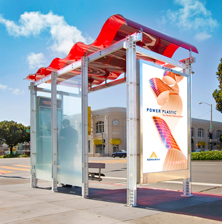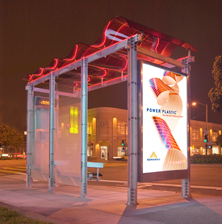The Challenge: Reinvent the traditional transit shelter to take advantage of solar power. The Solution: Create a next-generation transit shelter that is both environmentally innovative and aesthetically pleasing.
Case Study: San Francisco MTA Transit Shelter
Stona Fitch | Konarka
The lowly bus shelter doesn’t always get a lot of respect—or attention. But when the San Francisco Municipal Transportation Agency (MTA) decided to upgrade the city’s urban transit shelters in 2008, it wanted to bring new technology and innovative thinking to the challenge. Its goals were both functional and aesthetic. In short, the shelter had to provide comfortable shelter for bus passengers, look great on the street, and reflect the city’s unique qualities—all while being durable enough to survive harsh urban conditions for as long as 25 years.
Power Plastic fuels an innovative design
 As part of the city’s extensive commitment to green technology, the new design also had to integrate the latest advances in environmental efficiency and sustainability—from solar power to recycled materials. Designers submitted dozens of different approaches, which were ultimately displayed at City Hall as models. After the inherently long process was over, a creative approach spearheaded by Lundberg Design (and its client, Clear Channel Outdoor) won the contest, and the contract.
As part of the city’s extensive commitment to green technology, the new design also had to integrate the latest advances in environmental efficiency and sustainability—from solar power to recycled materials. Designers submitted dozens of different approaches, which were ultimately displayed at City Hall as models. After the inherently long process was over, a creative approach spearheaded by Lundberg Design (and its client, Clear Channel Outdoor) won the contest, and the contract.
A critical differentiating element of the design is its unique, red/amber undulating roof, which references the legendary hills of the city, the waves of the San Francisco Bay, and seismic waves. Embedded within this translucent roof, you’ll find Konarka Power Plastic®—which enables the transit shelters to generate power and be largely self- sufficient from an energy perspective. Power generated by Power Plastic is used to fuel LED lighting at night, “NextBus” LED signage, and built-in Wi-Fi routers that provide free access to commuters.
In fact, Konarka Power Plastic panels not only power the structure, but also create new solar power for the city via two-way connections to the power grid. Ultimately, the city expects that the new transit shelters will channel an estimated 43,000 kilowatt-hours back into the grid annually. The new design transforms transit shelters from power consumers into power generators—all while providing the protection and information that travelers rely on. Plus it introduces new capabilities, such as Internet access, that enhance the overall experience—capabilities fueled by Power Plastic.
Combining flexibility and durability— plus beauty
“Power Plastic is a great material,” says Ryan Hughes, project manager at Lundberg Design. “It’s really appealing from a design and functionality point of view. And it was exactly what we were looking for in a solar material.”
Other competitive designs integrated solar power, but used traditional, rigid panels that imposed significant limitations. Power Plastic’s flexibility enables it to integrate seamlessly with the unique, wave-shaped canopy, while its translucence gave the roof a singular and attractive appearance. “I really like how you can see strips of light and patterns coming through the photovoltaic material,” says Ryan. And beyond how it looks, the modularity and simplicity of Power Plastic made it ideal for us.”
3form, the leading manufacturer of award winning sustainable building materials, developed and fabricated the shelter canopies. The 3form Advanced Technology group collaborated with Konarka to integrate the Power Plastic (including the electrical interconnections) within the roof. “It was a very smooth working relationship,” says Hughes. “Konarka and 3form have been great partners throughout the process.”
The Results?
Starting with a prototype shelter on a residential section of Geary Street, new shelters are rolling out throughout the city. Of the more than 1,200 shelters of various sizes, about 300 will include solar capability fueled by Konarka Power Plastic. Some shelters are located in low light areas where any solar capability would be impractical.
The city’s new transit shelters have been receiving rave reviews and awards—even at this early stage. The city launched the Geary Street prototype with a high-profile grand opening featuring the mayor and other dignitaries. Since then, it has continued to get a lot of attention from people waiting for the bus and other passersby, becoming an unlikely tourist destination. The shelter has been featured (and praised) in dozens of publications, from Fortune to Popular Mechanics to Interior Design. And it has won key awards, including the prestigious Spark Award.
Why Konarka?
 The benefits that Konarka brings to this project start with the powerful attributes of Power Plastic—and then go further:
The benefits that Konarka brings to this project start with the powerful attributes of Power Plastic—and then go further:
The right capabilities.
Power Plastic provides the flexibility, durability, and efficiency required by this unique design challenge. Available in quantity, simple to integrate, lightweight, and effective even in indirect lighting environments, and Power Plastic’s organic photovoltaic technology was the clear choice for Lundberg Design.
An attractive look.
As a visible element of the transit shelters, Konarka Power Plastic had to do more than perform efficiently for years, turning light into energy. It had to look great as well. Power Plastic’s unique appearance combined functionality with beauty, giving a unique look to the transit shelter’s distinctive canopy.
A commitment to collaboration.
Konarka worked together with Lundberg Design, 3form, and others throughout the design, prototyping, and testing phases to ensure that Power Plastic was compatible with the polycarbonate material of the canopy, and protected from the environment. Konarka managers and engineers provided the ability to satisfy all of the project’s diverse stakeholders by meeting various design, technical, and aesthetic needs.
Find Out More Today
The San Francisco MTA transit shelter is just one of the many wide-ranging, innovative designs to integrate Konarka Power Plastic. To find out more, call Konarka at +1-978-5691400 or visit www.konarka.com.
The content & opinions in this article are the author’s and do not necessarily represent the views of AltEnergyMag
Comments (0)
This post does not have any comments. Be the first to leave a comment below.
Featured Product

